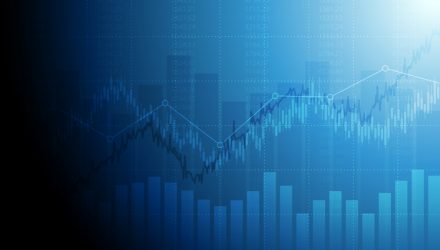By Brandon Rakszawski, Senior ETF Product Manager for VanEck Global
The search for yield continues to dominate discussions among advisors, investors and asset managers more than 10 years after the global financial crisis. As the Federal Reserve continues to cut U.S. interest rates and the amount of negative yielding government debt increases globally, investors find themselves seeking income in excess of the meager levels available from savings accounts and government bonds.
This has led to previously obscure ETF categories, such as bank loans and preferred securities, gaining traction and raising significant assets over the last decade. Investors have also taken on elevated risk from more traditional asset classes to squeeze incremental income from ETFs investing in high yield corporate and municipal bonds and real estate securities.
A notable long-term trend has been that investors have increasingly turned to stocks for income. The spread between 30-Year Treasury and S&P 500 Index yields have compressed over the last decade, and in August of this year, the S&P 500 converged with 30-Year Treasury bonds to the narrowest spreads since 2008.
Spreads Compressing, Stock Yields More Compelling
December 2006 – September 2019

Source: FactSet.
These dynamics have fueled the influx of investment in dividend-focused stock ETFs globally. These dividend strategies generally feature a dividend yield in excess of the broad U.S. equity market and, in many cases, in excess of many segments of the bond markets.
Growth of Global Dividend-Focused ETPs

Source: Morningstar. *2019 data through 9/30/2019.
Beware of Dividend Traps
Many dividend strategies, whether active or indexed, tend to fall into one of two camps: strategies targeting high yield stocks, or strategies that focus on companies that have a consistent history of paying dividends or increasing dividends. Both can be sound strategies, and many investors may even combine the two schools of thought to isolate high yielding companies that have grown dividend distributions over time. But, these strategies aren’t without risk. While dividend investment strategies as a whole may have featured lower volatility and in turn an attractive risk/reward profile when compared to the broad market, relying solely on historical characteristics can lead to unintended risks—namely, dividend traps.
Focusing on high yielding stocks can lead investors to areas of the market that have been under recent duress (as stock prices fall, yield generally rises) or to companies for which the market requires an attractive yield as compensation for ownership. Many high yielding stocks are high yielding for a reason. Similarly, relying solely on a company’s history of dividend payments can lead to situations like 2008 and 2009, when many companies with a decades-long track record of paying distributions were forced to suspend shareholder payments.
Approach Dividend Investing from a Position of Strength: A Durable Dividends Strategy
The forward-looking approach of assessing company valuations and financial health sets the Morningstar US Dividend Valuation Index (the “Dividend Valuation Index”) apart from other backward-looking strategies. The Dividend Valuation Index, which underlies the VanEck Vectors Morningstar Durable Dividend ETF (DURA), targets high yielding companies that appear attractively priced and display strong financial health.
Fair Value: A decade’s worth of steady investor flow to dividend paying stocks paired with U.S. equity markets reaching all-time highs make valuation considerations particularly important. Morningstar’s 100-person equity research team assigns a fair value estimate to each company it covers by projecting cash flows well into the future. Think of fair value as a company’s current worth based on its future earnings potential. This approach may allow for greater upside potential while maintaining an attractive dividend yield.
Finding Yield at a Better Value
Data as of 9/30/2019

Source: Morningstar. Premium/discount to fair value represents index constituent market prices relative to Morningstar’s equity analyst-assigned fair value estimate. Fair value and dividend yield figures displayed as a weighted average of the index constituents. Index performance is not representative of fund performance. For fund performance current to the most recent month-end, visit vaneck.com. For illustrative purposes only. Past performance is no guarantee of future results.
Financial Health: Focusing on yields and valuation alone may not be enough. Also important is a company’s ability to maintain or grow dividend payments. The Dividend Valuation Index relies on a predictive measurement of financial health, distance to default. This contrasts with the backward-looking approach of tracking a company’s historical trends with the hope that those trends persist. Distance to default reflects a firm’s likelihood of bankruptcy and has historically been an effective predictor of dividend cuts. Selecting companies with the lowest probability of default helps reduce the probability of future dividend cuts.
Higher Distance to Default Scores Resulted in Fewer Dividend Cuts
May 2005 – May 2018

Source: Morningstar. U.S. companies in the Morningstar Global Markets Index were assigned to quartiles at the beginning of the period based on the likelihood of default using Morningstar’s Distance to Default scoring system. Those companies with the highest likelihood of default (“Very Low” Distance to Default scores) had the highest occurrence of subsequent dividend cuts. The inverse is also true. For illustrative purposes only. Past performance is no guarantee of future results.
By considering a company’s future, Morningstar’s analysis helps to assess dividend durability and attractive allocation opportunities among high yielding stocks. DURA offers investors access to this approach to investing in stocks with durable dividends as the search for yield continues.
Disclosures







